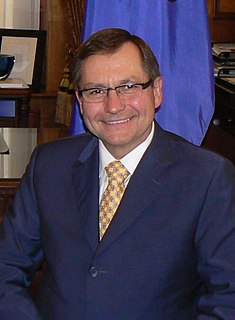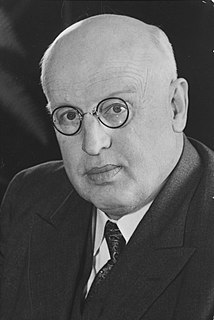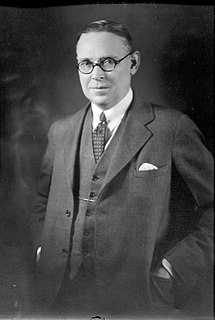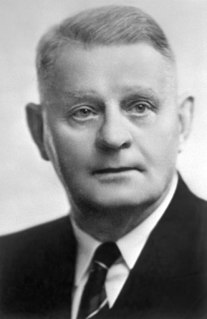
Charles Stewart, was a Canadian politician who served as the third premier of Alberta from 1917 until 1921. Born in Strabane, Ontario, in then Wentworth County, Stewart was a farmer who moved west to Alberta after his farm was destroyed by a storm. There he became active in politics and was elected to the Legislative Assembly of Alberta in the 1909 election. He served as Minister of Public Works and Minister of Municipal Affairs—the first person to hold the latter position in Alberta—in the government of Arthur Sifton. When Sifton left provincial politics in 1917 to join the federal cabinet, Stewart was named his replacement.

The Executive Council of Alberta, or more commonly the Cabinet of Alberta, is the Province of Alberta's equivalent to the Cabinet of Canada. The government of the province of Alberta is a constitutional monarchy and parliamentary democracy with a unicameral legislature—the Legislative Assembly, which consists of 87 members elected first past the post (FPTP) from single-member constituencies. The premier is normally a member of the Legislative Assembly, and usually draws the members of Cabinet from among the members of the Legislative Assembly. The legislative powers in the province however, lie with the Legislative Assembly of Alberta. Its government resembles that of the other Canadian provinces. The capital of the province is Edmonton, where the Alberta Legislative Building is located. Government is conducted after the Westminster model.

The Government of Alberta refers to the provincial government of the province of Alberta. Its powers and structure are set out in the Constitution Act, 1867.
Executive councils in the provinces of Canada are constitutional organs headed by the lieutenant governor and composed of the ministers in office. The executive branch of the Canadian federal government is not called an executive council; instead, executive power is exercised by the Canadian Cabinet who are always members of the King's Privy Council for Canada.
The Alberta order of precedence is a nominal and symbolic hierarchy of important positions within the province of Alberta. It has no legal standing but is used to dictate ceremonial protocol at events of a provincial nature.
- The Sovereign: His Majesty King Charles III
- Lieutenant Governor of Alberta: Her Honour the Honourable Salma Lakhani
- Premier of Alberta: The Honourable Danielle Smith
- The Chief Justice of The Court of Appeal of Alberta: The Honourable Justice Frans Slatter
- Former lieutenant governors of Alberta
- The Honourable Donald Ethell
- The Honourable Lois Mitchell
- Former premiers of Alberta
- The Honourable Ed Stelmach
- The Honourable Alison Redford
- The Honourable Dave Hancock
- The Honourable Rachel Notley
- The Honourable Jason Kenney
- Speaker of the Legislative Assembly of Alberta: Nathan Cooper
- Ambassadors and high commissioners accredited to Canada
- Members of the Executive Council of Alberta, in relative order of precedence as determined by the premier
- Leader of the Official Opposition: Rachel Notley
- Current members of the King's Privy Council for Canada resident in Alberta, with precedence given to current members of the federal cabinet
- Members of the Legislative Assembly of Alberta with precedence governed by the date of their first election to the Legislature
- Members of the Senate of Canada, who represent Alberta by date of appointment
- The Honourable Douglas Black
- The Honourable Scott Tannas
- The Honourable Patti LaBoucane-Benson
- The Honourable Paula Simons
- Members of the House of Commons of Canada who represent Alberta constituencies by date of election
- Superior court justices
- Chief Justice of the Court of King's Bench of Alberta: The Honourable Justice M.T. Moreau
- Justices of the Court of Appeal of Alberta
- Justices of the Court of King's Bench of Alberta
- Heads of religious denominations
- Heads of consular posts: consuls-general; consuls; vice-consuls; consular agents
- Judges of the Provincial Court of Alberta
- Chief Judge of the Provincial Court of Alberta
- Other judges by seniority of appointment
- Mayors of Alberta municipalities
- Aboriginal Leaders
- Chiefs of the Treaty First Nations in Alberta, in order of seniority of election to office;
- President of Métis Settlements General Council
- President of Métis Nation of Alberta: Audrey Poitras
- Deputy Minister to the Premier and Cabinet Secretary
- Clerk of the Legislative Assembly
- Ombudsman
- Provincial Auditor
- Chief Electoral Officer: Glen Resler
- Ethics Commissioner: Marguerite Trussler
- Information and Privacy Commissioner: Jill Clayton
- Deputy Ministers
- Senior Alberta government officials with rank of Deputy Minister as determined by the Executive Council
- Chief executive officers of Crown corporations
- Leadership of Alberta universities
- Chancellor of the University of Alberta: Ralph B. Young
- Chancellor of the University of Calgary: Jim Dinning
- Chancellor of the University of Lethbridge: Shirley McClellan
- Chairman of the Board, University of Alberta
- Chairman of the Board, University of Calgary
- Chairman of the Board, University of Lethbridge
- Chairman of the Board, Athabasca University
- Chairman of the Board, Mount Royal University
- Chairman of the Board, MacEwan University
- President of the University of Alberta: David H. Turpin
- President of the University of Calgary: Ed McCauley
- President of the University of Lethbridge: Michael J. Mahon
- President of Athabasca University: Frits Pannekoek
- President of Mount Royal University: David Docherty
- President of Grant MacEwan University: David W. Atkinson
- Police and military
- Commanding Officer, "K" Division, Royal Canadian Mounted Police: Curtis Zablocki
- Commander, 3rd Canadian Division: Brigadier-General W.H. Fletcher
- Commanding Officer, HMCS Nonsuch
- Commanding Officer, 1 Canadian Mechanized Brigade Group
- Commanding Officer, 1 Area Support Group
- Commanding Officer, 41 Canadian Brigade Group
- Commanding Officer, 4 Wing
Lyle Eldon Stewart is a Canadian provincial politician. He is a current Saskatchewan Party member of the Legislative Assembly of Saskatchewan.

The Klein Ministry was the combined Cabinet, chaired by Premier Ralph Klein, and Ministers that governed Alberta from the mid-point of the 22nd Alberta Legislature from December 14, 1992, to the mid-point of the 26th Alberta Legislature until December 14, 2006.

The Stelmach Ministry was the combined Cabinet, chaired by thirteenth Premier Ed Stelmach, and Ministers that governed Alberta shortly after the conclusion of the first session of the 26th Alberta Legislature from December 14, 2006, to the mid-point of the fourth session of the 27th Alberta Legislature on October 7, 2011.

The Redford Ministry was the combined Cabinet, chaired by fourteenth Premier Alison Redford, and Ministers that governed Alberta halfway through the fourth session of the 27th Alberta Legislature from October 7, 2011, to the early part of the second session of the 28th Alberta Legislature on March 23, 2014.

The Hancock Ministry was the combined Cabinet, chaired by 15th Premier of Alberta Dave Hancock, that governed Alberta from March 23, 2014 to September 15, 2014. It was made up of members of the Progressive Conservative Party (PC).
The Getty Ministry was the combined Cabinet, chaired by Premier Don Getty, and Ministers that governed Alberta from the mid-point of the 20th Alberta Legislature from November 1, 1985, to nearly the end of the 22nd Alberta Legislature until December 14, 1992.
The Lougheed Ministry was the combined Cabinet, chaired by Premier Peter Lougheed, and Ministers that governed Alberta from the 17th Alberta Legislature from September 10, 1971, to mid-point of the 20th Alberta Legislature until November 1, 1985.
The Strom Ministry was the combined Cabinet, chaired by Premier Harry Strom, and Ministers that governed Alberta from the party way through the 16th Alberta Legislature from December 12, 1968, to end of the end of the 16th Legislature and the swearing in of Premier Peter Lougheed on September 10, 1971.

The Manning Ministry was the combined Cabinet, chaired by Premier Ernest Manning, and Ministers that governed Alberta from the part way through the 9th Alberta Legislature from May 31, 1943, to mid-point of the 16th Alberta Legislature on December 12, 1968.

The Aberhart Ministry was the combined Cabinet, chaired by Premier William Aberhart, and Ministers that governed Alberta from the 8th Alberta Legislature from September 3, 1935, to mid-point of the 9th Alberta Legislature on May 23, 1943.

The Reid Ministry was the combined Cabinet, chaired by Premier Richard Gavin Reid, and Ministers that governed Alberta from part way through the 7th Alberta Legislature from July 10, 1934, to September 3, 1935.

The Brownlee Ministry was the combined Cabinet, chaired by Premier John Edward Brownlee, and Ministers that governed Alberta from part way through the 5th Alberta Legislature from November 23, 1925, to part way through the 7th Alberta Legislature on July 10, 1934.

The Greenfield Ministry was the combined Cabinet, chaired by Premier Herbert Greenfield, and Ministers that governed Alberta during the 5th Alberta Legislature from August 13, 1921 to November 23, 1925.

The Sifton Ministry was the combined Cabinet, chaired by Premier Arthur Sifton, and Ministers that governed Alberta party way through the 2nd Alberta Legislature beginning on May 26, 1910, through the 3rd Alberta Legislature to October 30, 1917.

The Rutherford Ministry was the combined Cabinet, chaired by Premier Alexander Cameron Rutherford, and Ministers that governed Alberta from province's Confederation into Canada on September 2, 1905, to party way through the 2nd Alberta Legislature on May 26, 1910.














